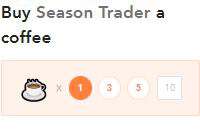Market Radar 3. January 2023
Market
Do we only see a flash in the pan at the beginning of the year or sometimes a “phoenix flying up from the ashes”?
Time spans and numbers do not match
On the last trading day of 2020, the ETF on the S&P 500 (SPY) was trading at 361.23 points. On the last trading day of 2022, the ETF on the S&P 500 (SPY) traded at 382.43 points. From a two-year perspective, investors were able to achieve a return of 5.87% with a passive investment in the S&P 500.
Is this whitewashing because we ignore the bear market in 2022 – at least in the numbers? There is no minus sign in the paragraph above!
Time spans cannot be described with numbers anyway. Long periods of time are always epic. We know this from compound interest: the longer the time spans become, the numbers there provide values that seem to have more to do with science fiction than with serious calculations.
What happened on the stock market a fortnight ago, I usually forgot five days later. 14 – 5 = 9. As I have just said, time spans and numbers do not go together. Result 9 is as irrelevant here as the return I achieved between May 2022 and July 2022. I could check now. Should I?
If I had just done that, then I would now tell a story – how I felt on the stock market back then. Which stock deceived me from May. Which stock I followed for too long. Which stock I discovered too late. Such stories are much more exciting than results wrested from periods of time.
To take it to the extreme: PayPal (PYPL) has lost more than 30% from a two-year perspective. If you want to sugarcoat PayPal – as I did above with the S&P 500 – you have to look back to New Year’s Eve 2017. From the perspective of five years, PayPal has brought a return of almost 70%! That’s 14% return p.a.! So PayPal is still a good investment; at least for those who have been around for five years or more.
If you want to be successful on the stock market, you have to look back on the long term. It’s like real life.
Get the Seasonal Tradingsignals on you cell phone
That’s why focus on the here and now
In this column, however, I cannot afford the luxury of looking back two years. The market radar is primarily about the changes in the here and now. Why? In order to identify at an early stage where rotations and shifts arise for the near future. I focus on risk-on / risk-off parities: How do risk-on and risk-off pairs relate to each other here and now? Who is following whom, in intermarket analysis, is the question of all questions (not: to be or not to be!).
Two examples:
At the beginning of 2023, we see that shares of companies that make their money with cyclical consumer goods such as furniture, cars, expensive handbags, jewelry (risk-on) are usually close to lows. Shares of companies that earn their money with non-cyclical consumer goods such as staples, beverages, household goods (risk-off) are usually quoted far away from lows.
As long as it stays that way, the bears drive the cars and the bulls have to make do with a bottle of Selters.
Likewise, quite a lot of cyclical industrial stocks from the mechanical engineering, steel, metal processing sectors are trading near their highs, while many stocks from the Internet, software, technology sectors are often (but not always!) trading more than 50% below their 2021 highs.
The cops despair at the computer, the bears remain hard as steel.
With the start of the new year, the major US stock indices (S&P 500, Nasdaq 100, Russell 2000) receive the daily stamp “wait and see or speculate on sell-off”. The same applies to the ETF for IPO stocks. For me, this means one thing above all: waiting. Now it is important to observe in the market radar which index returns first to the purchasable range:
If this is going to be the S&P 500, then there will probably only be a bear market rally again.
If this is going to be the Nasdaq 100, then there could at least be a chance for a trend change from the bear market to the bull market.
If this is going to be the Russell 2000, then the chances of a trend change are even higher.
If this is going to be the IPO ETF, then for me it means: Now I’m going all-in long.
Fallen Angels at the beginning of the year prefer not to short
For today, we are awarding numerous entry stamps on the short side at risk-on industries such as cannabis, cryptocurrencies, internet and Cathie Wood stocks.
But I think it’s risky to set up short sales via swing set-ups in stocks like Tilray (TLRY), Coinbase (COIN), Zoom (ZM) or Tesla (TSLA). Because at the beginning of a year, the losers of the previous year are often bought. This can only be a flash in the pan that we will have long forgotten in three weeks’ time. Personally, I also assume a flash in the pan rather than a beacon.

